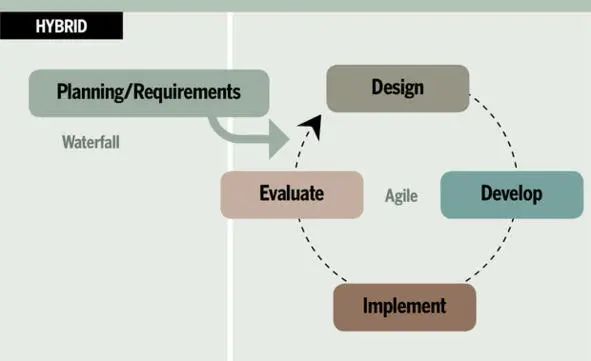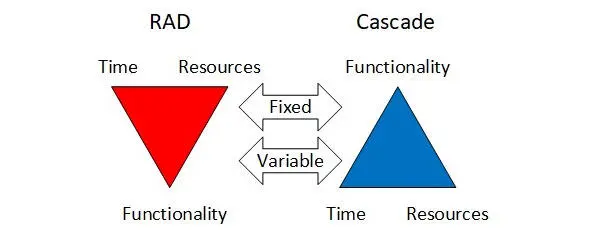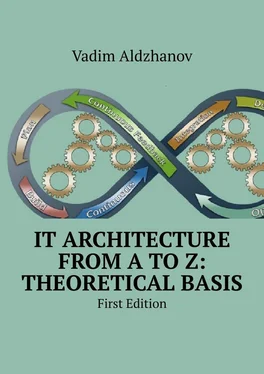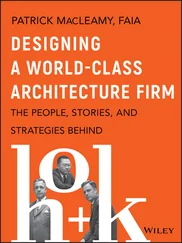Hybrid Project Management Methodology
Even though many teams prefer either a waterfall methodology or AGILE design, the benefits of both approaches have led to the emergence of a hybrid methodology where the stages of planning and definition of are carried out according to the waterfall methodology, and the design, development, implementation, and evaluation phases correspond to a flexible approach. This methodology is an attempt to apply the strengths of each main approach, as well as reduce the negative impact of weaknesses. The hybrid methodology can be well-applicable to IT since the project has well-defined goals at the managerial level, is well documented, and provides the ability to monitor the project status to report to the leadership. During implementation, the project assignments are well detailed and understandable to the developers due to the high communication level between business representatives and executors. The opportunity of on-job learning, making mistakes and improving the product to the current business requirements is equally good for developers and businesses. Of course, everything has to be paid for. This approach imposes requirements on both the technical level of employees training and their personal qualities.

Hybrid Model
From my own experience of project management in the IT department, this approach should not be implemented at the very beginning. However, as the IT department and business work together on several projects, this method will be a logical continuation and the most effective and productive one.
Other methods and approaches to project management
Rapid Application Development (RAD)
Rapid Application Development (RAD) is a specific project methodology, most often used in software development projects whose main purpose is to create an application quickly and efficiently.

Diagram “Comparison of WATERFLOW and RAD approaches”
The essence of this methodology is an approach to creating software development tools, emphasizing the speed and convenience of programming, creating a workflow that allows a programmer to create computer programs as quickly as possible. Practical definition: RAD is the life cycle of a design process designed to achieve higher development speed and software quality than the traditional design approach allows. This project management methodology identifies four project stages:
• Requirements planning;
• User design;
• Rapid construction;
• Cutover.
The main benefits of using various RAD approaches:
• Application of an iterative approach to the solutions development. The iterative approach implies carrying out work simultaneously with the continuous analysis of the results and the adjustment of the previous stages of work, i.e. feedback. When using this approach the project has a recurring cycle of Planning-Implementation-Verification-Evaluation. Iterative approach enables RAD’s prompt response to changing business requirements.
• An incremental approach implies the sequential development of a service “from piece to piece”. At the same time, each “piece” can support one of the business functions for which the service is developed. The incremental approach allows business the use some significant part of the service before it is fully developed. The additional benefits are: the product enters the market faster, there are more opportunities to develop a user-friendly interface, and it has greater adaptability to changing business requirements and simplicity of development and changes in the solution functionality. The methodology of rapid application development, on the one hand, helps improve project performance indicators and the quality of risk management. But on the other hand, this metrology is not suitable for large-scale IT projects, as it can lead to poor code quality and requires constant customer’s involvement in the execution of the entire project. RAD is a more modern and flexible design approach.
The deficiencies are a weak document base that can lead to misunderstandings, errors in the formation and development, the complexity of monitoring and auditing the development process. When designing services, incremental and iterative approaches can be combined. Once the entire service requirements are defined, its individual parts can be incrementally developed.
Extreme Programming XP
This project management methodology provides capabilities of short development cycles, frequent releases and open interaction with stakeholders. The teams focus on collaboration, efficiency, and productivity, writing the simplest possible codes to achieve the desired quality, avoiding exhaustion and poor quality results.
Event Chain Methodology (ECM)
This project management methodology helps identify and predict potential risks. Analyzing a project using the Monte Carlo method and the Event Chain Diagram helps determine the likelihood of some risks and their possible impact on the entire project. Visualizing the links between external events and project work helps create a plan which is as real as possible.
Adaptive Project Framework (APF)
Using the Adaptive Project Framework enables improving the project at each stage, based on the previous experience. By defining the project objectives and constantly monitoring the project work, the manager can ensure the success of the highest possible business value and create business value for the potential consumer.
Benefit Realization (BF)
The objective of Benefit Realization method is the benefit from the project implementation. Success is defined as the achievement of the desired / expected benefit. If customers want to increase sales of customer relationship management (CRM) software, the project will not be terminated / implemented until sales get increased by 15% – even if CRM is installed and set up duly and within the estimated budget.
Principles-based, Sustainable Project Management (PRISM) methodology
PRISM combines project planning with environmental sustainability measures. If you want to go in the green direction, PRISM has been designed especially for you! Decreasing energy consumption and distribution costs (cost sharing) are enhanced with reducing your environmental impact.
In addition to above-mentioned, there are other project management methodologies:
• Feature Driven Development (FDD),
• Dynamic Systems Development (DSDM),
• Rational Unified Process (RUP),
• Six Sigma and lean production (LEAN). Project management based on the principles of “quality control” will be discussed in detail in the next chapter.
Projects IN Controlled Environments (PRINCE2) is a structured project management project management methodology. It is one of the most popular project management methodologies, widely used by the UK business and government. PRINCE2 is Process-Based Project Management (PBPM) that focuses on top-level processes (management, organization, control), and not on lower-level tasks (work decomposition, schedule development).
The PRINCE2 methodology is based on seven principles, seven themes and seven processes. The principles are the core element of the methodology: if at least one of them is not implemented, the project is not carried out via PRINCE2.
Читать дальше














